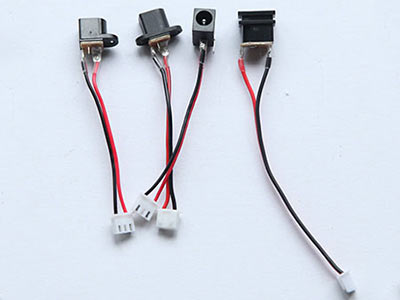DC socket cable, that is, DC socket connection cable, is a plug with a power cord connected between the power adapter and the device, which is widely used in a variety of equipment that requires DC power supply. Different types of DC cable have differences in specifications, uses, performance and so on. The following is an overview of each type of DC seat line:
A common DC seat line model
There are many models of DC seat line, common including but not limited to the following:
UL series: such as UL1007, UL1015, UL1032, UL1061, UL1185, UL1429, UL1430, UL1431, etc. These models are mainly differentiated according to voltage grade, temperature grade, wire diameter and other parameters, and are suitable for different internal connections of electronic and electrical equipment.
Specific specifications: such as 2.35×0.7TVdc plug, 3.0×0.1TVdc plug, 2.5×0.75TVdc plug and so on. These specifications mainly describe the outer and inner diameter dimensions of the DC socket, as well as possible other characteristics, such as voltage level, current carrying capacity, etc.
Two, the main parameters of DC seat line
Voltage level: Different types of DC base lines are suitable for different voltage levels, such as 300V, 600V, 1000V, etc. This determines the maximum voltage that the DC base line can withstand.
Temperature rating: The temperature rating indicates the maximum operating temperature of the DC base line under certain conditions, such as 80°C, 105°C, 125°C, etc. This affects the insulation performance and service life of the DC base line.
Wire diameter size: The wire diameter size is expressed by AWG (American wire gauge), such as 32AWG, 16AWG, etc. The larger the diameter of the wire, the larger the cross-sectional area of the wire and the stronger the current carrying capacity.

Material: The conductor material of DC base wire is usually copper or copper alloy, and the surface may be plated with tin, silver and other metals to improve electrical conductivity and corrosion resistance.
Insulation layer: The insulation layer is a key part of protecting the conductor from external environmental interference and mechanical damage, usually made of PVC, XLPE (cross-linked polyethylene) and other materials.
Three, DC seat line application field
DC base line is widely used in a variety of equipment requiring DC power supply, including but not limited to:
Digital products: such as mobile phones, tablets, digital cameras, etc.
Small household appliances: such as electric fans, hair dryers, humidifiers, etc.
LED lighting: such as LED lamp strips, LED bulbs, etc.
Audio equipment: such as sound systems, microphones, etc.
Communication equipment: such as routers, switches, etc.
Medical equipment: such as blood pressure monitors, thermometers, etc.
Four, precautions
When selecting and using the DC seat line, the following points need to be noted:
Compatibility: Ensure that the specifications and models of the DC base cable match the requirements of the device to avoid incompatibility or damage to the device.
Safety: Select the DC seat line that meets the safety standards to ensure that there will be no safety accidents such as electric shock and short circuit during use.
Durability: Consider the durability and service life of the DC seat line, choose products with reliable quality and stable performance.
Correct installation: Install the DC base line correctly according to the instruction manual or the guidance of professionals to ensure that the connection is firm and the contact is good.
To sum up, there are differences in specifications, parameters, application fields and other aspects of each type of DC cable, and the selection and use need to be comprehensively considered according to specific needs.
About
Company Profile Corporate imageApplication CasesProduct
News
Company News Industry News Common problem+86 769-81555631-808
Monday to Sunday 8:30-21:30
(Welcome to call us for consultation)
 App
App